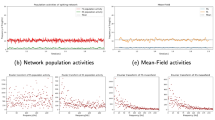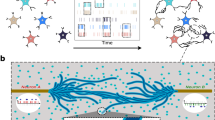Abstract
A software tool for studying neural networks grown on planar substrates is described. The tool provides: (i) modeling the neuritic fields of individual neurons and their dynamic connectivity, (ii) creation of templates, “cloning” and connecting multiple instances of the neurons, (iii) computing the cellular electrical activity and Ca2+ dynamics, and (iv) estimating synchronization of the networked cells. Examples are shown of employing this tool for the study of synchronization of burst discharges in a network of the cortical neurons, whose connectivity is modified by neuropsin.
Similar content being viewed by others
REFERENCES
Y. Kamioka, E. Maeda, Y. Jimbo, et al., “Spontaneous periodic synchronized bursting during formation of mature patterns of connections in cortical cultures,” Neurosci. Lett., 206, 109–112 (1996).
Y. Jimbo, T. Tateno, and H. P. C. Robison, “Simultaneous induction of pathway specific potentiation and depression in networks of cortical neurons,” Biophys. J., 76, 670–678 (1999).
M. A. Dent, Y. Sumi, R. J. Morris, et al., “Urokinase-type plasminogen activator expression by neurons and oligodendrocytes during process outgrowth in developing rat brain,” Eur. J. Neurosci., 5, 633–647 (1993).
C. M. Muller and C. B. Griesinger, “Tissue plasminogen activator mediates reverse occlusion plasticity in visual cortex,” Nat. Neurosci., 1, 47–53 (1998).
Z.-L. Chen, S. Yoshida, K. Kato, et al., “Expression and activity-dependent changes of a novel limbic-specific serine protease gene in the hippocampus,” J. Neurosci., 15, 5088–5097 (1995).
K. Kato, T. Kishi, T. Kamachi, et al., “Serine proteinase inhibitor 3 and murinoglobulin I are potent inhibitors of neuropsin in adult mouse brain,” Biol. Chem., 276,No. 18, 14562–14571 (2001).
S. Komai, T. Matsuyama, K. Matsumoto, et al., “Neuropsin regulates an early phase of Schaffer-collateral long-term potentiation in the murine hippocampus,” Eur. J. Neurosci., 12, 1479–1486 (2000).
P. F. Pinsky and J. Rinzel, “Synchrony measures for biological neural networks,” Biol. Cybern., 73, 129–137 (1995).
Author information
Authors and Affiliations
Corresponding author
Rights and permissions
About this article
Cite this article
Samarin, A.V., Igarashi, Y. & Korogod, S.M. Modeling of a Developing Planar Network of Cortical Neurons for Studying the Effects of Pharmacologically Modified Synaptic Connectivity on Cell Rhythmogenesis. Neurophysiology 34, 219–221 (2002). https://doi.org/10.1023/A:1020775905501
Issue Date:
DOI: https://doi.org/10.1023/A:1020775905501




